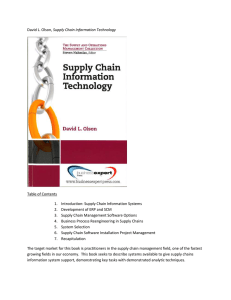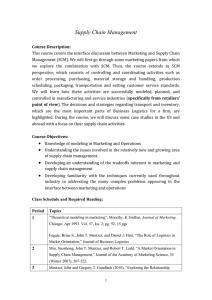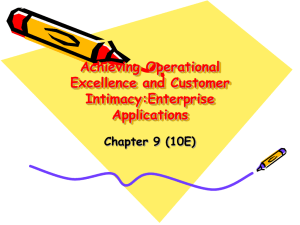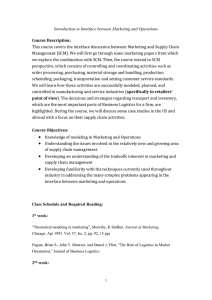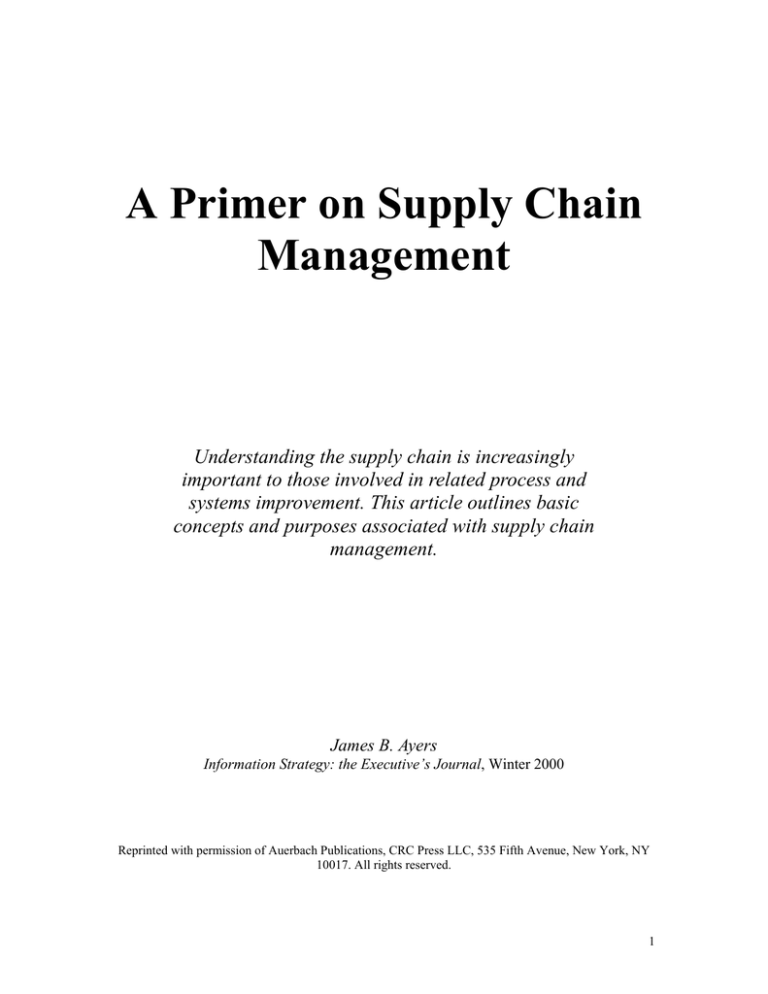
A Primer on Supply Chain
Management
Understanding the supply chain is increasingly
important to those involved in related process and
systems improvement. This article outlines basic
concepts and purposes associated with supply chain
management.
James B. Ayers
Information Strategy: the Executive’s Journal, Winter 2000
Reprinted with permission of Auerbach Publications, CRC Press LLC, 535 Fifth Avenue, New York, NY
10017. All rights reserved.
1
The definition of a supply chain can legitimately be broad or narrow depending on the perspective of the
“definer.” The trend is to broaden the definition of the supply chain. One speaker at a recent conference
sponsored by the Council of Logistics Management (CLM) described it broadly. We paraphrase: “the
supply chain is all that happens to a product from dirt to dust.” The supply chain begins, in the speaker’s
view, with mining ores and growing crops, extracting raw material from Mother Earth. The chain goes on
to a multitude of conversion and distribution processes that deliver the product to the end user. It ends with
ultimate disposal – presumably back to Mother Earth somewhere.
What follows here are some basic concepts and viewpoints of the supply chain. An awareness of these
should improve the quality of dialog on the subject in a number of organizations.
Defining supply chain management
Defining terms is a start in clarifying the supply chain discussion. The natural beginning is a working
definition of supply chain. The supply chain is more than the physical move of goods “from earth to earth.”
It is also information, money movement, and the creation and deployment of intellectual capital.
Supply chain...
Life cycle processes supporting physical, information, financial, and knowledge flows for
moving products and services from suppliers to end-users.
The following terms break down the definition further:
1.
Life cycle refers to both the market life cycle and the usage life cycle. These aren’t the same for both
durable goods and services. That computer, a product, and that 30-year mortgage, a service, must be
supported long after newer products replace older ones. Many products may be sold in a time window
that is relative short compared with their useful lives. For this reason, the longevity of the seller and its
reputation for product support are important factors in the purchasing decision. After-sales support can
be the most lucrative service provided – outpacing the money made on the original sale.
2.
Physical, information, and financial flows are frequently cited dimensions of the supply chain. The
traditional viewpoint of supply chains as only physical distribution is too limiting. Less frequently
mentioned is the role of knowledge inputs into supply-chain processes. Knowledge is as important as,
if not more than, physical and other types of inputs. A good example is new product development.
This supply chain process requires close coordination of intellectual input (the design) with physical
inputs (components, prototypes, and the like). Today added value in the form of intellectual capital is
vital to marketing profitable goods and services.
Services also have supply chains. Production planning for the product development department, which
produces designs, not products, can benefit from the same techniques used by product manufacturers.
Federal Express operates a service business, but it is certainly also a complex supply chain. A software
company is challenged to constantly improve their product through upgrades. Its process is also a supply
chain.
The term product describes the basic product or service. The extended product includes the basic product
or service, the supply chain that delivers it, plus other features and factors that go along with the product or
service.
In many markets, there may be little difference in products. However, there can be great differences in
extended products. Examples are the broadened choices we have for buying personal computers. We can
purchase them in a store (like the laptop from a leading maker), over the Internet (like a heavily discounted
“no-name” desktop version), or by telephone. The furniture industry offers another example of varied
channels. We can buy assembled furniture at a neighborhood store or go to a warehouse operation like Ikea
and buy it unassembled.
Choice begins with a need for the basic product or service but quickly moves to extended product factors
such as delivery, service, and reputation. For many products, the supply chain design is perhaps the single
most important extended product feature. Refer to Exhibit 1.
2
Exhibit 1. Extended Product
Dealer quality
Quality
Availability/delivery/selection
Options/features
Styling
Base Product
Warranty
Once these decisions are made, decisions still need
to be made based on “extended product” features.
These tend to be more subtle and intuitive. The
Exhibit shows some “outside the box” factors one
might consider. These include dealer quality,
selection, brand image, support service, and resale.
The supply chain enters into a number of these
extended product factors. Below are a few examples:
Extended Product
After-sale service
When we decide we need a car, decisions must be
made. We must decide what type of car – factors
associated with the physical “base product.”
Should the car be large or small? New or used?
How many seats should it have? What should it
cost?
Comfort
Brand image
Financing terms
Resale
Dealer quality: Dealers for most auto companies are the distribution backbone. How they operate, their
facilities, and their reputations are key factors in the buying decision.
Availability/delivery/selection: Having the right model at the right time for the right buyer often means a
sale. Supply chain cycle times and information systems improve the chances of being successful.
After-sale service/warranty: Many buyers look to this important support network when buying. For
many dealers, this service is their most lucrative.
Financing: Except for those who pay cash, the convenience and speed of this closely related service may
make or break a deal.
Resale: Many outlets for resale will raise the market value. So will all the factors that contribute to the
car’s reputation.
Many products we buy or contemplate buying have similar customer dynamics. A poorly executed basic
product will not succeed in the market. On the other hand, a well-done product does not necessarily assure
success. When competitors loom, it will be the basic product supplemented with extended product features
that will most likely succeed.
The term “supply chain management” is gaining currency, implying there is something different about
managing the supply chain. In fact, the acronym, SCM, is employed as shorthand for the term.
Supply chain management (SCM)...
Design, maintenance, and operation of supply chain processes for satisfaction of end user needs.
We feel that SCM is a discipline worthy of a distinct identity. This identity puts it on a level with
disciplines like finance, operations, or marketing. The above definition reflects the idea that SCM extends
to both the supply chain formulation and its subsequent operation and maintenance. SCM creates new
challenges for managers. Old missions must be achieved in new ways. In general, SCM is broadening the
roles of many.
Supply chain paradigms
Supply chains and the tasks that go with SCM very much depend on the eyes of the beholder. Different
companies and even managers in a single company have different viewpoints, or paradigms. And these are
evolving rapidly. There is no right or wrong supply chain viewpoint. In fact, the view in one company
3
probably should differ from the view in another. This is because their situations are surely different, and
what makes one successful won’t work for another. Also, the right viewpoint is not static. As time moves
on and competitive pressures shift, the need to change viewpoints will arise.
Below are descriptions of generic perspectives and ways to tie them together.
Functional
The functional supply chain viewpoint is what exists in most companies today. It is the “base” state.
Companies that don’t think in supply chain terms fit the functional paradigm. In this view, companies are
composed of individual departments. Manufacturing company examples include procurement, operations,
engineering, and distribution. Each department has, to a large degree, its own agenda. Oversight of links
between departments is weak within the company. Between companies in the supply chain, it’s practically
non-existent.
Performance evaluation in these companies is typically cost-dominated. Procurement is measured on the
purchase cost of material and material overhead rates. Manufacturing has measures such as direct labor
productivity. Distribution effectiveness is measured on the percentage of selling price represented by
distribution cost.
In the functional organization, strong department heads sponsor change. “Cross-talk” among departments
is minimal; so most initiatives are local. They may or may not improve the supply chain as a whole. The
actual impact on the total supply chain usually isn’t measured where the functional viewpoint prevails.
Procurement
Frequently, the move away from the functional viewpoint begins with efforts to lower material cost. This
viewpoint gave rise to the “supply” in “supply chain.” In many product-making organizations today, the
cost of material is the largest cost component. So, to quote a famous bank robber, management goes
“where the money is.” When you talk of the supply chain, these companies think of suppliers and
procurement.
Service organizations also buy many goods and services. Many look for ways to consolidate their demand
for support items such as office supplies, having realized they spend ample amounts. Many service
organizations also depend on other suppliers. For example, auto insurers have large networks of repair
shops and adjusters. Healthcare is also an industry of networked providers. These include medical groups
of doctors, hospitals, and insurers.
The cost of outside material and services makes this an attractive target for cost reduction. This brings on
programs such as sourcing initiatives, supplier reduction programs, and vendor-managed inventory (VMI).
In this paradigm, the procurement executive may take charge of the supply chain.
These efforts reach outside the company into the upstream supplier base. They include “partnering” with
the supplier and shrinking the supplier base. Often, especially when the buyer dominates the seller,
partnership talk centers on price reductions. Usually this shifts profits from one party to another in the
chain without fundamental improvement.
Logistics & transportation
The idea of companies linked together has roots in the logistics field. Of course, physical movement of
products along stages in the supply chain is an important part of most national economies. The previously
mentioned CLM defines “logistics” as:
“Logistics is that part of the supply chain process that plans, implements, and controls the
efficient, effective flow and storage of goods, services, and related information from the point of
origin to the point of consumption in order to meet customers’ requirements.”
Note that CLM includes both goods and services in its definition. It also takes note of “customers’
requirements” and the need to fulfill these.
In the logistics and transportation paradigm, when companies decide to anoint a supply chain executive,
4
they will likely pick the distribution executive. In place of the supply chain term, these companies may turn
to an alternative, the demand chain. This reflects attention paid to the outbound, rather than the inbound
side, or supply side, of the business.
The logistics view often addresses the outbound, downstream side in much the same way the procurement
viewpoint worked the inbound side. This is also a cost reduction effort aimed at incremental improvements
in profit. Typical activities include modeling warehouse, distribution center, and transportation networks to
reduce cost.
Information
The information viewpoint seeks to improve the links both within the company and within the supply
chain. New applications, plus new ways of moving information around, make this an active area.
Electronic Data Interchange (EDI) is an early example of ways to improve communications among
companies. One barrier has been the lack of integrated software both inside and outside the company.
Efforts underway sponsored by organizations like the Supply-Chain Council seek to standardize definition
of data elements and processes. This facilitates supply chain information sharing along the supply chain.
Dramatic results have come from the use of information to improve supply chain performance. A
frequently cited example is Wal-Mart, which moves point of sale data back through its system to its
suppliers. This reduces the need for forecasting in supply-chain decision-making.
One shortcoming associated with this perspective is the lack of “process consciousness.” Efforts to
implement new systems often become all encompassing, absorbing time, staff, and money resources. The
effort drives toward implementation of the technology, not necessarily improvement in underlying
processes.
Business process reengineering
Business process reengineering (BPR) efforts call for “radical” restructuring of processes to eliminate
waste and improve quality. The efforts take many forms. For example, new systems and reengineering are
closely linked in many minds. “Six Sigma” is a quality initiative that’s also a close cousin of BPR. Systems
and technology designs should follow process design. This is the intent of BPR. So the underlying process
requirements, not the technology itself, are the dominant force behind the change. The technology becomes
an “enabler.”
Most BPR efforts are confined to one company. But BPR across multiple members of the supply chain will
be increasingly common.
Strategic
Some view supply chain design as integral to their strategies for competing. For them, competing centers
not only on products but also on the operations that make up the “extended product.” These operations put
products into customers’ hands. With this viewpoint, supplier relations, logistics, and information systems
support customer satisfaction. This, in turn, leads to increased market share and profit. Costs, while
important, are secondary.
This last view was discussed in depth in Winter 1999 edition of the Journal. All projects to implement a
new supply chain or to change an existing one will affect the organization’s ability to compete. This impact
is better planned than left to chance.
5
Evidence of the impact
The business press, plus our own experiences as consumers, reinforces an important message: Supply
chains in many industries are rapidly evolving. The following are examples – many of which may be
familiar. Each situation reflects how the “extended product,” which includes the supply chain has become a
competitive battleground. We then continue to describe the dangers of ignoring changes in the supply
chain.
Case studies
Different industries and companies view supply chains and supply-chain change in different ways. These
changes reflect broad undercurrents and may not be seen by participants in the industry. These examples
call attention to these undercurrents in a few selected industries. We do this through the eyes of industry
observers and commentators. We term this “buzz.” What they have to say points to the growing importance
of supply chain management in coming years. In the examples, we call this “spin.”
Personal computers
As this article was written, this is one of the most discussed, most commented on industries on the face of
the planet. It holds lessons because of its speed of growth and the rapid evolution of its supply chains.
What observers say – the buzz
The industry began as a high growth, high profit business with most sales coming from retail stores.
However, the product itself evolved to where there are only minor differences between company offerings.
In fact, much of the product innovation effort centers on producing cheaper and cheaper machines. Making
money by introducing ever-more sophisticated components like processors has exhausted its potential for
increasing sales dramatically. Consumers have found that lower performing machines are “good enough.”
Practical day-to-day use requires much less. So knock-off processors and low cost machines have
penetrated the market.
One response has been the emergence of alternative supply chains. Dell Computer sells direct over the
telephone or through its World Wide Web site. It has lowered overhead and improved cash flow by using
supplier capital to finance its business. Existing channels make it hard for other manufacturers to shift their
supply chains. They fear alienation of their retail partners if they bypass them and go direct. But the
pressure to have a direct outlet is irresistible. Internet sales are also growing. One software retailer,
Egghead, closed its entire retail chain focused on software and started selling hardware on the Internet.
The supply chain spin
These trends reflect the emerging dominance of supply chain design over product design. Personal
computer components and software are readily available to all producers. Manufacturing is in essence an
order-taking and final-assembly operation. Extended product activities, which are defined here as part of
the supply chain, have become the basis for competitive advantage. These features include customer
support, the ability to customize, rapid response, purchasing clout, and operating economies.
Entertainment
This is an industry where knowledge is the primary input in the production process. The material content in
the final product is trivial. A movie is something we buy from the video store for its entertainment value,
not for the tape and plastic spool that make up its package. The physical form of the product is a minor
portion of the price we pay. Over 90 per cent of our dollar is for intellectual “components” arising from the
creativity of artists, writers, directors, and producers.
6
One company’s challenge
Rhino Entertainment undertook an overhaul of its supply chain. Rhino’s specialty is re-release of popular
music in a broad range of genres. Rhino uses the knowledge of its music experts to decide what “packages”
will be successful in the market. Rhino then gains permission to publish their selections from license
holders. The licensers are varied large and small music companies. Product managers for assigned markets
decide how to promote the release in the marketplace.
Only after these steps does the actual physical product take shape. This involves transferring recordings of
the tracks (songs) from original sources, design of the packaging to attract buyers, and arranging
production with a contract manufacturer. At Rhino, only a third of those involved in the process actually
work on the physical aspects of the product. The remainder works with ideas, licensers, and the media.
Only 20 percent of the customer’s dollar goes to physical product; 80 percent goes to knowledge
requirements.
The Rhino process produces about 15 releases each month. At the beginning of the project, the process
took up to two years for any one release. An “uncontrollable” in the process was the time to get approvals
from licensers. Although permissions were usually granted, there was frequently considerable delay in
responding as requests for licenses queued up. This was considered, with much justification, as an “out of
control” factor. Another factor in the extended lead-time was the lack of concurrent processes. Rhino’s
internal production tasks were serial, with none starting before the next one was complete.
The old process resulted in a loss of control over the timing of releases. This in turn hobbled financial
planning and, more importantly, control over the timing of releases. Often sales were tied to key events.
Christmas music for Christmas is an obvious example. Winning Academy Award tracks timed for release
along with the Oscars is a less obvious one.
The supply chain spin
Rhino is an example of a company whose product is far more knowledge than tangible product. But
efficient production requires the same management and coordination one must give to a complex physical
product. So the domains of physical and intellectual products aren’t widely separated – if they are
separated at all. What we say throughout this book has application for supply chain intangibles that result
from innovative thinking as well as tangibles.
Adding value through brands
Branding defines the collective view we have of a product. Brands are built on reputations among
customers, product functionality, advertising and promotion, and awareness among potential buyers. Often
a company’s value will greatly exceed its book value. Book value is a calculated value determined by
accounting rules. These rules recognize tangible value in assets like brick and mortar and inventory. But
the “market cap” or value place on the company by investors may greatly exceed book value. Much of this
added value is due to brand value in an attractive market.
The buzz on brands
Branding is a vital component in building shareholder value. The brand distinguishes the company and its
products from a crowded competitive field. The importance of the brand increases in mature markets. In
growth situations, there is often market enough for everyone. Having enough product may be the principal
challenge. As capacity catches up with demand, the overall value of the brand becomes more and more
important. Brand image evolves from product to extended product features. Brand value increasingly shifts
from the physical product to other factors.
7
The supply chain spin
Channels...
Vans. This California shoe company caters to the youth market with skateboard parks and “hip”
gear. It sells through retailers, its own stores, and factory outlets.
Hand-holding...
Solar Turbines. This San Diego based division of Caterpillar sells on site power generation
equipment. It uses a “one touch” repair guarantee to assure customers of uninterrupted service.
Free stuff...
Free computers. On line services at one time competed for “eyeballs” by giving away the access
tool, a personal computer.
Staying power...
IBM. In its days of uncontested glory, decision makers couldn’t miss by buying “Big Blue.”
Lots of product...
On line booksellers. After Amazon’s early market success, it and rival Barnes & Noble started
competing on how many millions of titles they offer.
Cheap...
“Category killers. ”Staples and Home Depot use economies of scale to lower prices.
Roll-ups...
U.S. Filter. This company actively acquired companies providing water equipment and services.
When acquired for a premium, it was 15 times the size of its nearest competitor.
SCM – defensive and offensive weapon
There are many dangers in ignoring SCM as a discipline. The most serious is the loss of profitable
customers. The supply chain in Exhibit 4 illustrates this.
Exhibit 4. The Loss of Profitable Customers
Distribution
Center
Customer
Segments
Factory
Line 1
Line 2
Suppliers
Regional
Warehouse
The chain shows the physical movement of products through a network for a manufactured product. The
flow begins with several suppliers. They send raw material to a factory. Other material that requires no
conversion goes directly to warehouses that support customers. The factory outbound shipments supply a
distribution center or regional warehouses. The distribution center and warehouses support customers.
8
However, these customers aren’t homogeneous. They divide into segments, and each segment has distinct
requirements. These requirements may arise from differences in either the product itself or the extended
product, including customer service, information, and technical assistance. Sometimes companies fail to
recognize these segments and their distinct requirements. This leads to a “one size fits all” supply chain
design. In effect the supply chain is a compromise based on the demands of different segments, and no
segment is served as well as it should be.
The threat arises when a competitor perceives the service shortfall. That competitor detects an opportunity
and structures a focused supply chain based on the needs of an attractive segment. The result is shown
Exhibit 5.
Exhibit 5. Competitor’s Focused Supply Chain
Focused Competitor
Distribution
Center
Customer
Segments
Factory
Line 1
Line 2
Suppliers
Regional
Warehouse
The consequence is loss of a customer segment. Very often this segment is the most profitable. This is
because the competitor does his homework not only on the supply chain features needed to serve the
segment but also on the economics of delivering those features. This process may occur over long periods
of time and be seen as erosion of market share. More often, it can be dramatic – executed by an upstart
company from outside the industry.
This threat is also an opportunity. SCM enables one’s own enterprise to “pick off” entrenched competitors,
so SCM is both a defensive and offensive weapon. Managers with responsibility for supply-chain decisions
– and that includes many in most organizations – should prepare to meet both the challenges and
opportunities that will surely find them.
9

